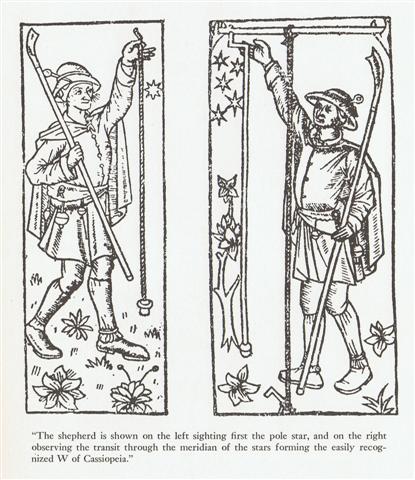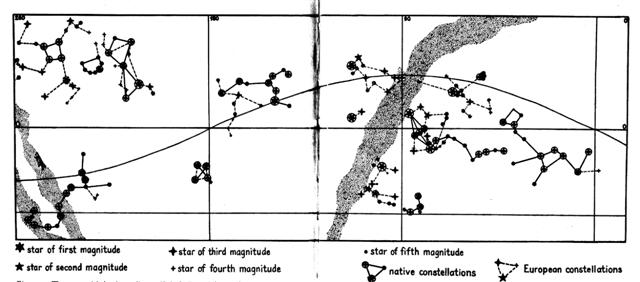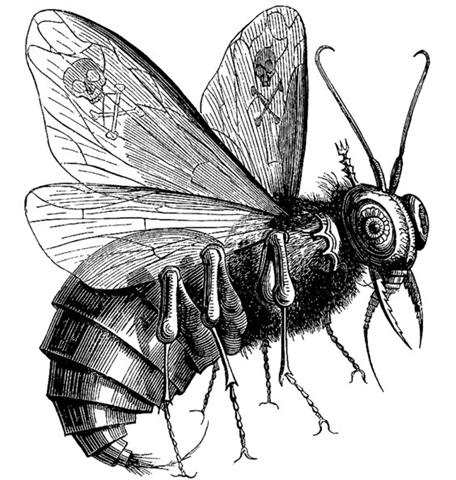In the Chinese system, we have learned, there were associative links connected with the stations, for instance a Fox at the Heart:
... In the inscriptions of Dendera, published by Dümichen, the goddess Hathor is called 'lady of every joy'. For once, Dümichen adds: Literally ... 'the lady of every heart circuit'. This is not to say that the Egyptians had discovered the circulation of the blood. But the determinative sign for 'heart' often figures as the plumb bob at the end of a plumb line coming from a well-known astronomical or surveying device, the merkhet. Evidently, 'heart' is something very specific, as it were the 'center of gravity' ... See Aeg.Wb. 2, pp. 55f. for sign of the heart (ib) as expressing generally 'the middle, the center' ... ... Proclus informs us that the fox star nibbles continuously at the thong of the yoke which holds together heaven and earth; German folklore adds that when the fox succeeds, the world will come to its end. This fox star is no other than Alcor, the small star g near zeta Ursae Majoris (in India Arundati, the common wife of the Seven Rishis, alpha-eta Ursae ... This method of association through hints was used also in the other systems. Thus there was a Hand (Κ) at the autumn equinox, at Raven:
And then there was a White ('Leprous') Spot at Heka (Al Hak'ah):
... The ruling chief has no corner on the means of production. Accordingly, he cannot compel his native subjects to servile tasks, such as providing or cooking his daily food, which are obligations rather of his own household, his own line, or of conquered people (nona tamata ga, qali kaisi sara). Yet even more dramatic conditions are imposed on the sovereignity at the time of the ruler's accession. Hocart observes that the Fijian chief is ritually reborn on this occasion; that is, as a domestic god. If so, someone must have killed him as a dangerous outsider. He is indeed killed by the indigenous people at the very moment of his consecration, by the offering of kava that conveys the land to his authority (lewaa). Grown from the leprous body of a sacrificed child of the native people, the kava the chief drinks poisons him ... Sacred product of the people's agriculture, the installation kava is brought forth in Lau by a representative of the native owners (mataqali Taqalevu), who proceeds to separate the main root in no ordinary way but by the violent thrusts of a sharp implement (probably, in the old time, a spear). Thus killed, the root (child of the land) is then passed to young men (warriors) of royal descent who, under the direction of a priest of the land, prepare and serve the ruler's cup ... the tuu yaqona or cupbearer on this occasion should be a vasu i taukei e loma ni koro, 'sister´s son of the native owners in the center of the village' ... Traditionally, remark, the kava root was chewed to make the infusion: The sacrificed child of the people is cannibalized by the young chiefs. The water of the kava, however, has a different symbolic provenance. The classic Cakaudrove kava chant, performed at the Lau installation rites, refers to it as sacred rain water from the heavens ... This male and chiefly water (semen) in the womb of a kava bowl whose feet are called 'breasts' (sucu), and from the front of which, tied to the upper part of an inverted triangle, a sacred cord stretches out toward the chief ... The cord is decorated with small white cowries, not only a sign of chieftainship but by name, buli leka, a continuation of the metaphor of birth - buli, 'to form', refers in Fijian procreation theory to the conceptual acception of the male in the body of the woman. The sacrificed child of the people will thus give birth to the chief. But only after the chief, ferocious outside cannibal who consumes the cannibalized victim, has himself been sacrificed by it. For when the ruler drinks the sacred offering, he is in the state of intoxication Fijians call 'dead from' (mateni) or 'dead from kava' (mate ni yaqona), to recover from which is explicitly 'to live' (bula). This accounts for the second cup the chief is alone accorded, the cup of fresh water. The god is immediately revived, brought again to life - in a transformed state ... Probably it means the creators of Manuscript E also used this method, to add significant details in order to make the meaning clear. For instance:
... There was no water in the village. The lakes and rivers were dry. Raven and Crow, two young girls who were having their first menstrual courses, were told to go and draw water from the ocean. Finding the journey too long, Raven decided just to urinate into her basket-bucket. She decieved no one and was severly scolded. Crow returned much later but with drinking water. As a punishment, Raven was condemned never to find water in the summer; only in winter would she find something to drink. For that reason the Raven never drinks during the hot months; she speaks with a raucous voice because of her dry throat ... Futhermore, even in the myths were used apparently insignifant small details for conveying meaning. The yellow urine was a potent fertilizer. And Anakena 27 evidently corresponded to "July 27 - a day of π (22 / 7):
... If the moral attitudes of primitive man are hard for the Western mind to grasp and translate into familiar terms, there can hardly be one more so than the Maori notion of cooked food as the lowest thing, the furthest opposite to the sacred, in fact filthy. For us to divest our minds of Christian notions of good and evil and substitute the concept of simple payment, harm for harm (or 'revenge', as we commonly call it with a misleading moral overtone), is simple enough - perhaps because every schoolchild has at some time known the latter in his horrid heart. Even the Maori custom of weeping over friends when they arrive instead of when they depart has a certain logic that is not beyond our comprehension. But to enter, against all conditioning, into the minds of a people for whom cooked food and the act of eating could carry the overtones of meaning that we in our greater wisdom attach to their physical opposites and to sex, is a good deal harder. One has somehow to throw the mind into a state of being that is radically unlike ours. Yet if the trick can be done, a light comes on ...
|
|||||||||||||||||||||||||||||||||||||||||||||||||||||||||||||||||||||||||||||||||||||||||





